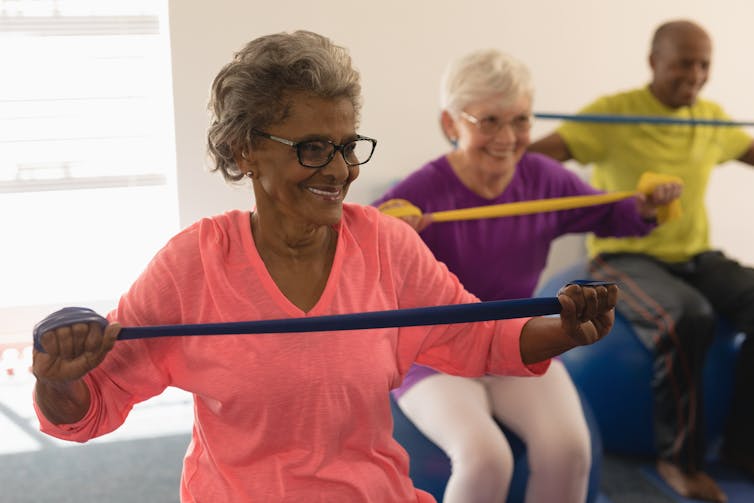Blog
The role of protein quality in the fight against muscle loss
Getting out of bed and using the toilet may be a relatively simple task for many people, but it becomes increasingly more difficult as we age. This happens because of one of the many changes in the body that come with aging: our muscles shrink and become weaker, a condition known as sarcopenia.
Most people are aware of the recommendations for regular physical activity and associated health benefits. They also know that good eating habits complement a healthy, active lifestyle. Unfortunately, few people know what to put on their plates to preserve their muscles as they age.
Food consists of three key energy-providing macronutrients: carbohydrates, fats and proteins. Protein – most often found in meat, fish, dairy products, eggs and, to varying degrees, in plants and grains – provides the building blocks (amino acids) for the construction of important body tissues, such as skeletal muscles.
Aging can reduce our ability to digest, absorb and use nutrients from food. To ensure that older people can continue to do what they love in their later years, we must emphasize the importance of increasing the amount and quality of the protein they eat.
Why more protein matters for older people
Unlike carbohydrates, which are stored in the muscles and liver in the form of glycogen, and fats, which are stored in adipose tissue, we have no place to store excess proteins/amino acids. So we need to eat enough protein every day to provide our cells with the materials they need to function properly.
Current recommendations protein intake is the same for all adults, regardless of age: 0.8 grams of protein per kilogram of body weight per day (g/kg/d). However, estimates indicate that as many as 30-76 percent of older people they don’t consume enough protein.
Because the muscles of older people are not able to use dietary protein as effectively as younger people to maintain muscle, experts suggest that older adults who want to maintain muscle should consume about 50 percent more protein (1.2 g/kg/day).
Quality, not (only) quantity
Eating more protein is certainly one way to overcome age-related muscle building disordersbut this may not always be feasible for older people – especially those with less appetite or those with dental problems. Another strategy is to improve protein quality and spread your intake evenly throughout the day.

(Shutterstock)
The quality of protein is determined by two key factors: the content of essential amino acids and the degree of its digestion and absorption.
Leucine, one of the nine essential amino acids, turns on muscle building processes in the body. Thus, proteins with higher leucine content are generally considered better for muscle growth.
Due to concerns about ethical food production and environmental sustainability, interest in plant-based protein sources is growing. Pea protein is one example of a promising protein plant source of protein which contains enough leucine. However, we know little about its effect on muscle building in older people.
Plant protein for older muscles
Being part of Stuart Phillips’ research group in McMaster Institute for Aging ResearchI was driving A randomized controlled trial in humans to investigate the impact of protein quality on the rate of muscle building in older people.
We subjected 31 adults aged 60 to 80 years to a strict dietary intervention consisting of two stages: a seven-day control phase during which participants received protein according to current recommendations (0.8 g/kg), followed by a seven-day supplementation phase, in which participants were randomly assigned to consume an additional 25 grams of protein supplement – whey, pea or collagen – at breakfast and lunch, for a total of an additional 50 grams per day.

(Shutterstock)
Supplements were consumed at breakfast and lunch as these are typically participatory meals lowest protein content for older people.
We then performed a muscle biopsy, which showed that consuming higher-quality protein supplements (whey and pea) at breakfast and lunch increased muscle building in older adults by almost 10%. However, collagen protein – a supplement widely advertised to older people – did nothing to enhance muscle building in older people. as a previous study also showed.
Adding more protein to your diet can improve muscle building, but the protein must contain enough essential amino acids, especially leucine.
We also showed that plant sources of protein can be as effective as animal protein sources in building muscle in older people.
We debunk popular myths about protein
If you’re worried about increasing your protein intake because it may impact other aspects of your health, we have great news for you.
Increasing your protein intake is NOT give you cancer, cause kidney failure Or dissolve your bones.
Older adults who increase their intake of high-quality protein (and engage in regular physical activity) can help slow muscle loss and extend your years in good health.
Supplement your diet with adequate amounts of high-quality protein
The benefits of more protein in your diet go beyond muscles. Foods containing protein also provide other essential nutrients, such as vitamins, minerals and fiber from grain sources, and can help you feel fuller for longer, reducing the likelihood of excessive weight gain.
Make protein the focus of every meal and aim to eat about 25-40 grams – or about one to two palm-sized portions – of protein for breakfast, lunch and dinner. Preparing meals in advance and including protein-rich snacks can help you stay on track with your daily protein goals. Some good options include Greek yogurt, cottage cheese, dried meat, canned fish, eggs, and nuts.
Without a plan, sarcopenia can attack you. So regardless of your dietary preferences, protein from animal sources (meat, fish, eggs, dairy) or plant-based proteins (tofu, nuts, seeds, lentils) can provide you with the nutrients you need to maintain your muscles as you age.

